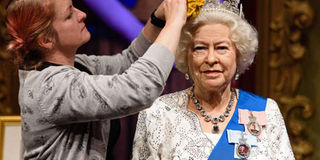All hail longest serving British monarch!

Stylist Jane Anderson poses with the re-styled wax figure of Britain’s Queen Elizabeth II, during a photocall at Madame Tussauds in central London yesterday. The figure has been refreshed with a recreation of the Queen’s Diamond Jubilee dress, in time for tomorrow, when Queen Elizabeth will become the longest reigning monarch
in British history. AFP PHOTO | LEON NEAL
What you need to know:
- The exact timing of this milestone remains unknown, but Queen Elizabeth II would have ruled over Britain and 15 other Commonwealth realms for 63 years and about eight months, and as the Head of the Commonwealth.
- As queen, she has stayed through Kenya’s independence from Britain, the fall of the Soviet Union and the Berlin Wall, one World Cup edition in England, one edition of London Olympic Games, the invention of colour television and mobile phone, to attain the status.
- The official record at Buckingham Palace, the Queen’s seat, says she became a monarch after receiving news of “her father’s death and her own accession to the throne, while staying in a remote part of Kenya.”
A young British monarch whose ascension to the throne was only by chance will on Wednesday become the longest reigning monarch in British history.
The exact timing of this milestone remains unknown, but Queen Elizabeth II would have ruled over Britain and 15 other Commonwealth realms for 63 years and about eight months, and as the Head of the Commonwealth.
By Wednesday, the 89-year-old monarch will overtake Queen Victoria, her great great grandmother, who reigned for 63 years, seven months and two days.
As queen, she has stayed through Kenya’s independence from Britain, the fall of the Soviet Union and the Berlin Wall, one World Cup edition in England, one edition of London Olympic Games, the invention of colour television and mobile phone, to attain the status.
As Head of the Commonwealth, she has been queen as the organisation morphed from purely British and former British colony members to include others such as Rwanda and Mozambique (colonised by Belgium and Portugal respectively.)
The story of her ascension began in Kenya, some 63 years ago. Kenya was still a British colony and Queen Elizabeth, then Princess Elizabeth (baptised Elizabeth Alexandra Mary), was staying at “their Kenyan home.”
The official record at Buckingham Palace, the Queen’s seat, says she became a monarch after receiving news of “her father’s death and her own accession to the throne, while staying in a remote part of Kenya.”
That remote part is today’s Nyeri County. On February 6, 1952, she was staying at Sagana Lodge after spending the previous night at Treetops Hotel when Prince Philip broke the news.
Yet becoming queen was not always expected. She was the first-born child of the then Duke and duchess of York, who would later become King George VI, and Queen Elizabeth I.
She was therefore the third in line of succession after King Edward VIII (born Prince Edward), and her father. Her father was not expected to become king either.
Things changed slowly when King George V (her grandfather), died in 1936. “His eldest son came to the throne as King Edward VIII, but, before the end of the year, King Edward VIII had decided to give up the throne in order to marry the woman he loved, Mrs Wallis Simpson,” states the Buckingham Palace website.
Princess Elizabeth’s father came to the throne as King George VI and was crowned in 1937. This brought Princess Elizabeth to be the first in line to succeed the throne.
When King George VI, who had reigned for 15 years, died, the Princess had to abandon her tour of Kenya and fly back to London as a Queen. She was 25 then, and would be crowned on June 2, 1953.
Though September 9 is the official date when this record will be set, the Palace has not released the exact time since King George VI’s death, actual time of death remains a mystery.
Tomorrow, the Palace is set to release souvenirs and hold exhibitions to celebrate the long reign.
Queen Elizabeth never went to formal school, but got her education at home.
“She received tuition from her father, as well as sessions with Henry Marten, the Vice-Provost of Eton. She was also instructed in religion by the Archbishop of Canterbury.”
“After her father succeeded to the throne in 1936 and she became heir presumptive, she started to study constitutional history and law as preparation for her future role,” states her biography.
She has studied music and art, loved horses and was a great swimmer who got enrolled as a Girl Guide. She is also fluent in French, a language she learnt while engaging with French and Belgian sovereigns.
Married to Prince Philip, they have four children (three sons and one daughter), eight grandchildren and five great-grandchildren.




